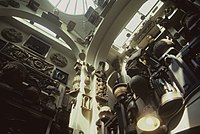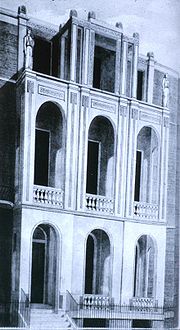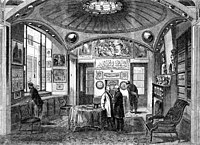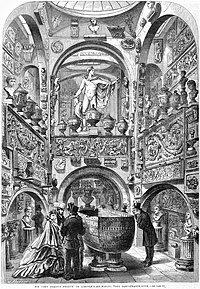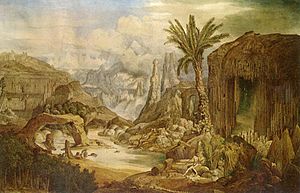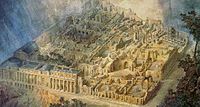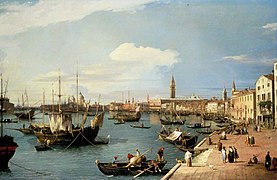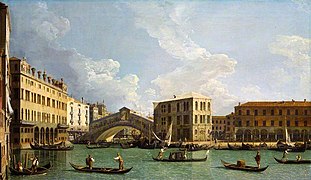Sir John Soane's Museum
| Sir John Soane's Museum | |
| Middlesex | |
|---|---|
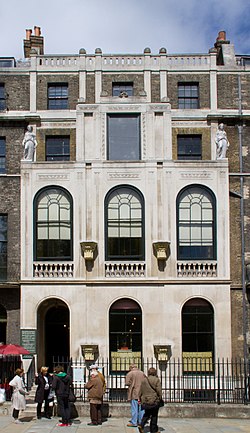
| |
| Location | |
| Grid reference: | TQ30728147 |
| Location: | 51°31’1"N, 0°7’3"W |
| History | |
| Address: | Lincoln's Inn Fields |
| townhouse | |
| Information | |
| Website: | http://soane.org |
Sir John Soane's Museum is a house museum, located next to Lincoln's Inn Fields in Holborn, London, in Middlesex, which was formerly the home of the neo-classical architect, John Soane.
The house holds many drawings and architectural models of Soane's projects, and a large collection of paintings, sculptures, drawings and antiquities that he acquired over many years. The museum was established during Soane's own lifetime by a Private Act of Parliament in 1833, which took effect on his death in 1837. Soane engaged in this lengthy parliamentary campaign in order to disinherit his son, whom he disliked intensely. The act stipulated that on Soane's death his house and collections would pass into the care of a Board of Trustees, acting on behalf of the nation, and that they would be preserved as nearly as possible exactly in the state they were at his death.
The museum's trustees remained completely independent, relying only on Soane's original endowment, until 1947 (since when it has received an annual Grant-in-Aid from the British Government via the Department for Digital, Culture, Media and Sport.
History
Houses
Soane demolished and rebuilt three houses in succession on the north side of Lincoln's Inn Fields. He began with No. 12 (between 1792 and 1794), externally a plain brick house. After becoming Professor of Architecture at the Royal Academy in 1806, Soane purchased No. 13, the house next door, today the museum, and rebuilt it in two phases in 1808–09 and 1812.
In 1808–09 Soane constructed his drawing office and "museum" on the site of the former stable block at the back, using primarily top lighting. In 1812 he rebuilt the front part of the site, adding a projecting Portland Stone façade to the basement, ground and first floor levels and the centre bay of the second floor. Originally this formed three open loggias, but Soane glazed the arches during his lifetime. Once he had moved into No. 13, Soane rented out his former home at No. 12 (on his death it was left to the nation along with No. 13, the intention being that the rental income would fund the running of the Museum).
After completing No.13, Soane set about treating the building as an architectural laboratory, continually remodelling the interiors. In 1823, when he was over 70, he purchased a third house, No. 14, which he rebuilt in 1823–24. This project allowed him to construct a picture gallery, linked to No.13, on the former stable block of No. 14. The front main part of this third house was treated as a separate dwelling and let as an investment; it was not internally connected to the other buildings. When he died No. 14 was bequeathed to his family and passed out of the museum's ownership.
Museum
The museum was established during Soane's own lifetime by a Private Act of Parliament in 1833, which took effect on Soane's death in 1837. The Act required that No. 13 be maintained "as nearly as possible" as it was left at the time of Soane's death, and that has largely been done. The Act was necessary because Sir John had a living direct male heir, his son George, with whom he had had a "lifelong feud" due to George's debts, refusal to engage in a trade, and his marriage, of which Sir John disapproved. He also wrote an "anonymous, defamatory piece for the Sunday papers about Sir John, calling him a cheat, a charlatan and a copyist".[1] Since under contemporary inheritance law George would have been able to lay claim to Sir John's property on his death, Sir John engaged in a lengthy parliamentary campaign to disinherit his son using a private Act, setting out to "reverse the fundamental laws of hereditary succession"[2] according to some. The Soane Museum Act was passed in April 1833 and stipulated that on Soane's death his house and collections would pass into the care of a Board of Trustees, on behalf of the nation, and that they should be preserved as nearly as possible exactly as they were left at his death.[3]
Towards the end of the 19th century (1889–90) a break-through was made to re-connect the rear rooms of No. 12 (north of the courtyard) through to the museum in No. 13 and since 1969 No. 12 has been run by the Trustees as part of the Museum, housing the research library (until 2009), offices and, since 1995, the Eva Jiřičná-designed 'Soane Gallery' for temporary exhibitions (until Summer 2011). The museum's trustees remained completely independent, relying only on Soane's original endowment, until 1947. Since that date the museum has received an annual Grant-in-Aid from the British Government (this now comes via the Department for Digital, Culture, Media and Sport).
Restoration projects
The Soane Museum is now a national centre for the study of architecture. From 1988 to 2005 a programme of restoration within the Museum was carried out under Peter Thornton and then Margaret Richardson with spaces such as the Drawing Rooms, Picture Room, Study and Dressing Room, Picture Room Recess and others being put back to their original colour schemes and in most cases having their original sequences of objects reinstated; Soane's three courtyards were also restored with his pasticcio (a column of architectural fragments) being reinstated in the Monument Court at the heart of the Museum. (Much of the cost of the work was financed by the Sir John Soane's Museum Foundation, in New York.)[4]
In 1997 the trustees purchased the main house at No. 14 with the help of the Heritage Lottery Fund.[3] The house was restored (2006–09) and has enabled the Museum to expand its educational activities, to re-locate its Research Library into that house, and to create a Robert Adam Study Centre where Soane's collection of 9,000 Robert Adam drawings is housed in purpose-designed new cabinets by Senior and Carmichael.
Opening up the Soane project, 2011–2016
The acquisition of No. 14 enabled the Museum to complete the restoration of the museum's historic spaces, in three phases:
- Phase 1 to re-configure No. 12 and the install lifts
- Phase 2 to restore of Soane's private apartments on the second floor. Lost rooms recreated include Soane's own bedroom and bathroom, which he showed to the public in his lifetime.
- Phase 3 to provide a new Study Room at the back of No. 12
Architecture
The most famous spaces in the house are those at the rear of the museum – the Dome Area, Colonnade and Museum Corridor. These are mostly toplit and provide some idea in miniature form of the ingenious lighting contrived by Soane for the toplit banking halls at the Bank of England. The ingeniously designed Picture Gallery has walls composed of large 'moveable planes' (like large cupboard doors) that allow it to house three times as many items as a space of this size could normally accommodate (the original hang in this room was reinstated in January 2011). When visiting, it is necessary to request the planes to be opened and wait for a group to gather before this is done.
The more domestic rooms of No. 13 are at the front of the house, many of them highly unusual, but often in subtle ways. The domed ceiling of the Breakfast Room, inset with convex mirrors, has influenced architects from around the world. The Library-Dining Room reflects the influence of Etruscan tombs and perhaps even gothic design in its repertoire of small pendants like those in fan vaulting. It is decorated in a rich 'Pompeian' red. The Study contains a collection of Roman architectural fragments and the two external courtyards, the Monument Court and Monk's Yard contain an array of architectural fragments, Classical in the Monument Court with its central column or 'pasticcio' representing Architecture and Gothic in the Monk's Yard, filled with mediæval stonework from the Palace of Westminster.
Collections
Antiquities, mediæval and non-western objects
As his practice prospered, Soane was able to collect objects worthy of the British Museum, including the Sarcophagus of Seti I, covered in Egyptian hieroglyphs, discovered by Giovanni Battista Belzoni, bought on 12 May 1824 for £2000 — Soane's most expensive art work.[5]
After the Seti sarcophagus arrived at his house in March 1825, Soane held a three-day party, to which 890 people were invited, the basement where the sarcophagus was housed was lit by over one hundred lamps and candelabra, refreshments were laid on and the exterior of the house was hung with lamps.[6] Among the guests were the then Prime Minister Robert Jenkinson, 2nd Earl of Liverpool and his wife, Robert Peel, Prince Augustus Frederick, Duke of Sussex, Samuel Taylor Coleridge, J.M.W. Turner, Sir Thomas Lawrence, Charles Long, 1st Baron Farnborough, Benjamin Haydon as well as many foreign dignitaries.[7]
Other antiquities include: Greek and Roman bronzes including ones from Pompeii, cinerary urns, fragments of Roman mosaics, Greek vases many displayed above the bookcases in the library, Greek and Roman busts, heads from statues and fragments of sculpture and architectural decoration, examples of Roman glass.[8]
Mediæval objects include: architectural fragments, mainly from the Old Palace of Westminster (acquired after the 1834 fire), tiles and stained glass.[8] Soane acquired 44 examples of 18th-century Chinese ceramics as well as 12 examples of Peruvian pottery.[9] Soane also purchased four ivory chairs and a table, believed to be made in Murshidabad for Tipu Sultan's palace at Srirangapatna.[10]
Sculpture
Francis Leggatt Chantrey carved a white marble bust of Soane that is still in the museum, in the ' Dome' overlooking the Seti sarcophagus.[11] Soane also acquired Sir Richard Westmacott's plaster model for Nymph unclasping her Zone, displayed at the back of the recess in the Picture Room.[12] Other acquisitions include: the plaster model of John Flaxman's memorial sculpture of William Pitt the Younger.[13] The model of Thomas Banks's monument to Penelope Boothby.[14]
Of ancient sculptures a miniature copy of the famous sculpture of Diana of Ephesus is one of the most important in the collection.[15] After the death of his teacher Henry Holland, Soane bought part of his collection of ancient marble fragments of architectural decoration, these were purchased by Charles Heathcote Tatham for Holland in Rome in 1794–96.[16]
Plastercasts of famous antique sculptures include: Aphrodite of Cnidus,[13] Hercules Hesperides[17] & Apollo Belvedere.[18] Soane also acquired a plastercast of the Sulis Minerva sculpture found in Bath.[19]
Paintings and drawings
Soane's paintings include: works by Canaletto entitled View of the Riva degli Schiavoni painted (1736) purchased in 1806 from William Thomas Beckford for 150 Guineas[20] plus three other works by the artist,[21] and paintings by Hogarth: the eight canvases of the A Rake's Progress, purchased from the collection of William Thomas Beckford, at auction for 570 Guineas in 1801,[22] the other Hogarth paintings Soane purchased were the four canvases of the Humours of an Election bought at auction at Christie's from David Garrick's widow for £1,732, 10s in June 1823.[23] Soane acquired three works by his friend J. M. W. Turner: the oil paintings Admiral Van Tromp's Barge entering the Texel and St Hugues Denouncing Vegeance on the Shepherd of Cormayer Val D'Aoust and the watercolour Kirkstall Abbey. Thomas Lawrence painted a three quarter length portrait of Soane, it is hung over the Dining Room fireplace in the museum.[24] Soane also has a painting by Antoine Watteau, a fête champêtre.[12] Soane owned one oil painting by Joshua Reynolds, entitled Love and Beauty, which hangs in the dining room over the sideboard.[25] Soane commissioned an oil painting from Augustus Wall Callcott c.1830, entitled The Passage Point -Italian Composition.[26] Other paintings include The Count of Revenna by Henry Fuseli, and The Landing of Richard II at Milford Haven by William Hamilton.[27] Soane acquired 15 drawings by Giovanni Battista Piranesi, many of which are framed and displayed in the museum.[9] Soane's friend John Flaxman, sketched Soane's wife, this is framed and displayed in the museum.[28] The collection also includes twenty-two works in gouache and bodycolour by Charles-Louis Clérisseau.[citation needed]
Architectural drawings and architectural models
There are over 30,000 architectural drawings in the collection. Of Soane's drawings of his own designs (many are by his assistants and pupils, most notably Joseph Gandy), covering his entire career, most are bound in 37 volumes, 97 are framed on the museum walls, and the rest are 601 covering the Bank of England, 6,266 of his other works, and 1,080 prepared for the Royal Academy lectures.[29]
In 1817 George Dance the Younger gave Soane a gift of a book containing architectural drawings by Christopher Wren, including Hampton Court Palace & Royal Naval Hospital.[30] A major coup for Soane's collection was the purchase of the 57 volumes of 8,856 drawings by Robert Adam and James Adam in 1821 for £200.[31] Another important architectural book was John Thorpe's book of architecture, purchased at an auction held at Christie's on 3 April 1810 and costing Soane twenty seven and half Guineas;[32] the book contains nearly 300 plans and elevations of Elizabethan architecture and Jacobean architecture, mainly large mansions. George Dance the Younger died in 1825, and in 1836 Soane purchased both George Dance the Elder's 293 and George Dance the younger's 1,303 surviving drawings from his son, which were housed in the Museum in a specially designed cabinet;[33] Sir William Chambers 789 drawings; James Playfair 286 drawings; other architects and artists with drawings in the collection include: Matthew Brettingham, Thomas Sandby, Humphry Repton, Joseph Nollekens, Peter Scheemakers, John Michael Rysbrack, and others, in total 1,635 drawings.[29] There are a large number of Italian drawings, including an early 16th-century bound volume by Nicolette da Modena; the Codex Coner early 16th century of Roman buildings; 213 mid-16th century drawings by Giorgio Vasari; 3 volumes of 16th to 17th-century drawings by Giovanni Battista Montano; 17th-century drawings by Giovanni Battista Gisleni; two volumes of 18th-century drawings by Carlo Fontana; Drawings of Paestum dated 1768 by Thomas Major; Margaret Chinnery's volume of miscellaneous drawings; plus six other volumes of various drawings.[34]
The 252 architectural models in the collection are: 118 of Soane's own buildings including 44 of the Bank of England, covering details, façades, rooms as well as complete buildings,[9] models of ancient Roman and Greek buildings, 20 made from plaster and 14 of Cork (material)|cork.[9] There are in addition 100 models of architectural details and ornaments.[9] The 20 plaster models are the work of Jean-Pierre Fouquet of Paris and were acquired by Soane in 1834 for £100,[35] these include: Erechtheion, Tower of the Winds, Mausoleum at Halicarnassus, Pantheon, Rome, Temple of Vesta, Tivoli, Temple of Antoninus and Faustina and the Temple of Portunus, the buildings are depicted as reconstructions not in their current ruined state.
See also
- Soane's country retreat Pitzhanger Manor.
Outside links
| ("Wikimedia Commons" has material about Sir John Soane's Museum) |
References
- ↑ "Biographies: Sir John Soane (1753–1837)". Berkshire History. http://www.berkshirehistory.com/bios/jsoane.html.
- ↑ "Sir John Soane's Museum. (Hansard, 1 April 1833)". Hansard.millbanksystems.com. http://hansard.millbanksystems.com/commons/1833/apr/01/sir-john-soanes-museum.
- ↑ 3.0 3.1 Soane Museum: Our History
- ↑ Paula Deitz (13 April 1995), Sir John Soane's New Tricks New York Times.
- ↑ Darley 1999, p. 274
- ↑ Darley 1999, p. 275
- ↑ Darley 1999, p. 276
- ↑ 8.0 8.1 Soane Museum 1991, p. 84
- ↑ 9.0 9.1 9.2 9.3 9.4 Soane Museum 1991, p. 85
- ↑ Knox 2009, p. 122
- ↑ Stroud 1984, p. 113
- ↑ 12.0 12.1 Knox 2009, p. 93
- ↑ 13.0 13.1 Knox 2009, p. 70
- ↑ Knox 2009, p. 83
- ↑ Knox 2009, p. 66
- ↑ Knox 2009, p. 60
- ↑ Knox 2009, p. 78
- ↑ Knox 2009, p. 120
- ↑ Knox 2009, p. 73
- ↑ Stroud 1984, p. 60
- ↑ Stroud 1984, p. 32
- ↑ Darley 1999, p. 148
- ↑ Darley 1999, p. 271
- ↑ Stroud 1984, p. 109
- ↑ Knox 2009, p. 57
- ↑ Stroud 1984, p. 86
- ↑ Sir John Soane's Museum (2018). Sir John Soane's Museum: A Complete Description. Sir John Soane's Museum. p. 31. ISBN 978-0-9932041-6-6.
- ↑ Stroud 1984, p. 101
- ↑ 29.0 29.1 Soane Museum 1991, p. 86
- ↑ Darley 1999, p. 253
- ↑ Tait 2008, p. 11
- ↑ Summerson 1966, p. 15
- ↑ Lever 2003, p. 10
- ↑ Soane Museum 1991, pp. 85–86
- ↑ Soane Museum 1991, p. 65
- Darley, Gillian (1999). John Soane: An Accidental Romantic. Yale University Press. ISBN 978-0-300-08165-7.
- A New Description of Sir John Soane's Museum: 9th Revised Edition. The Trustees of the Sir John Soane's Museum. 1991.
- Knox, Tim (2009). Sir John Soane's Museum London. Merrell. ISBN 978-1-85894-475-3.
- Lever, Jill (2003). Catalogue of the Drawings of George Dance the Younger (1741–1825) and of George Dance the Elder (1695–1768) from the Collection of Sir John Soane's Museum. Azimuth Editions. ISBN 978-1-898592-25-9.
- Stroud, Dorothy (1984). Sir John Soane Architect. Faber & Faber. ISBN 978-0-571-13050-4.
- John Summerson (1966). "The Book of John Thorpe in Sir John Soane's Museum". The Fortieth Volume of the Walpole Society 1964–1965 (The Walpole Society).
- Tait, A. A. (2008). The Adam Brothers in Rome: Drawings from the Grand Tour. Scala Publishers Ltd. ISBN 978-1-85759-574-1.
Books
- Reynolds, Nicole (2010). "Sir John Soane's House-Museum and Romantic Nostalgia". Building Romanticism: Literature and Architecture in Nineteenth-Century Britain. University of Michigan Press. ISBN 978-0-472-11731-4.
- Stourton, James (2012). Great Houses of London. Frances Lincoln. ISBN 978-0-7112-3366-9.
- Waterfield, Giles, ed (1996). Soane and Death. Dulwich Picture Gallery. ISBN 978-1-898519-08-9.
